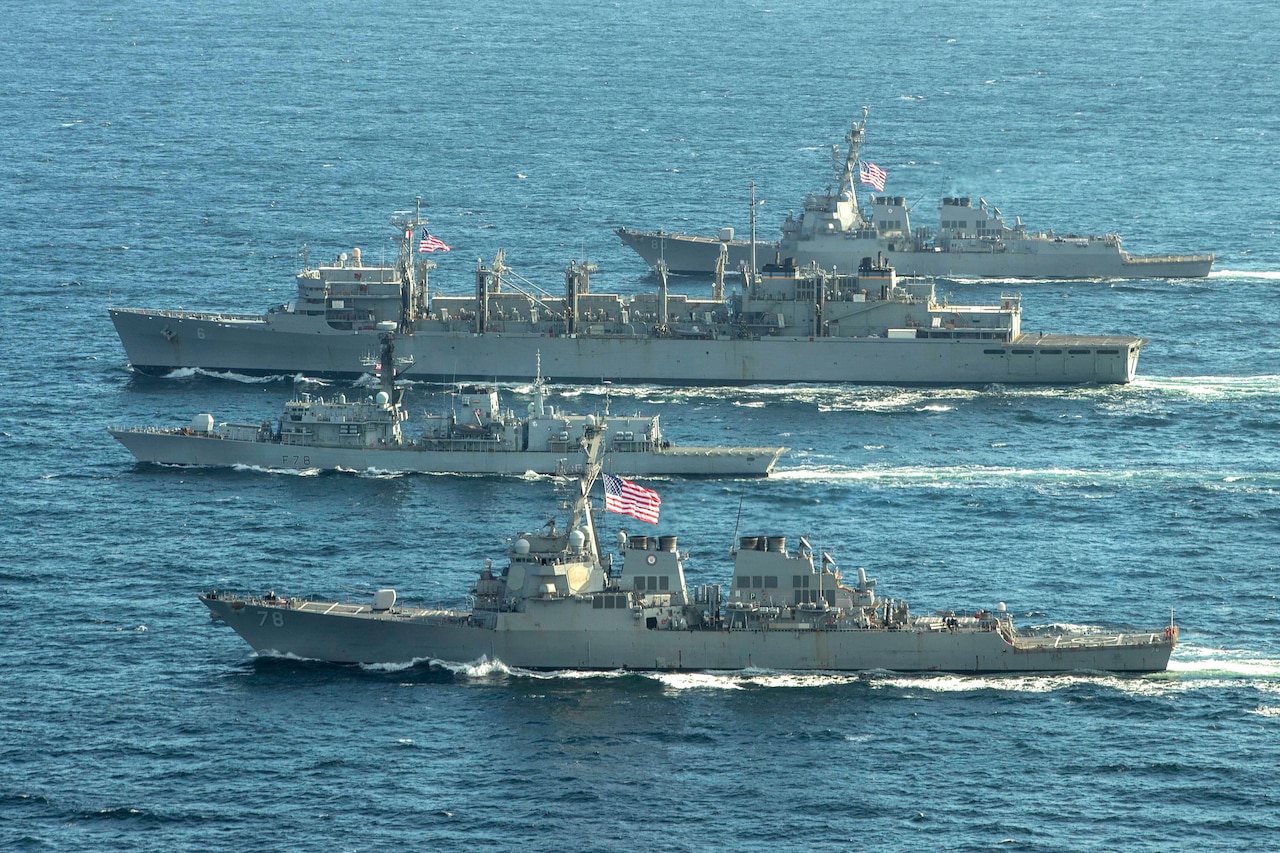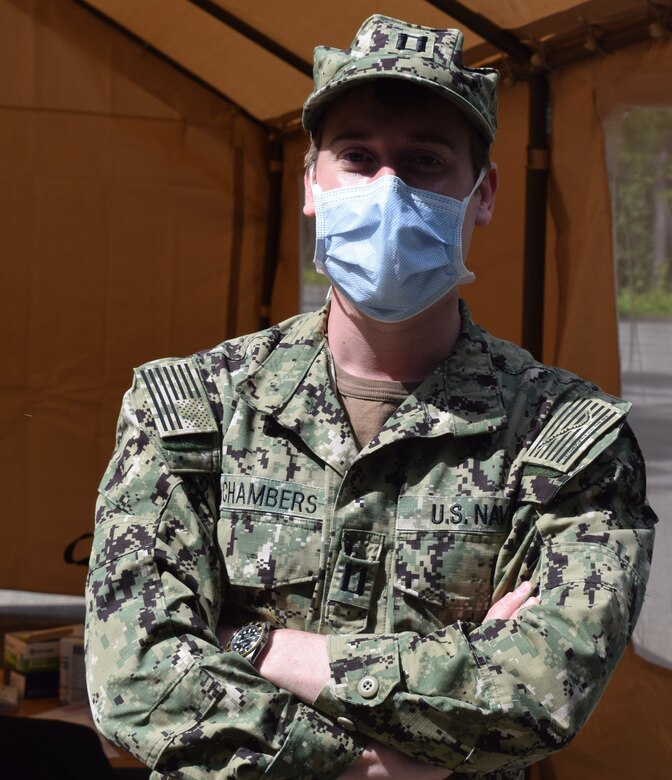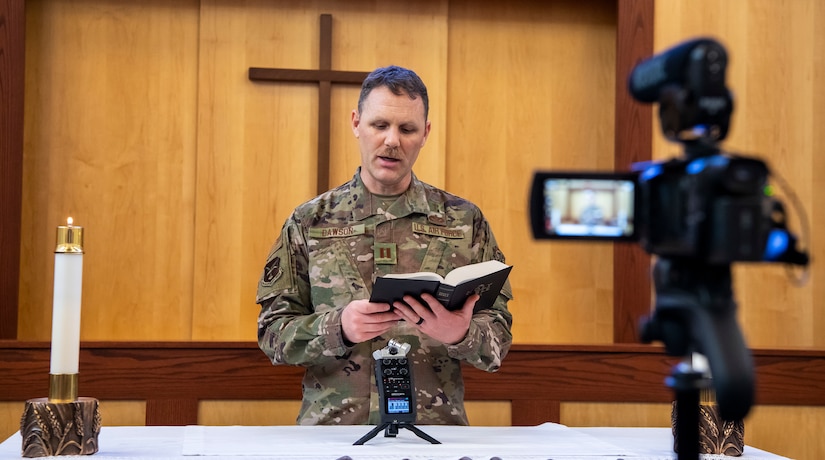May 7, 2020 | BY Douglas Stutz , Naval Hospital Bremerton
Navy Lt. (Dr.) Aaron Chambers, a doctor of podiatric
medicine and fellow of the American College of Foot and Ankle Surgeons, is
helping to stop the spread of COVID-19.
Chambers, originally from St. Louis is a 2006 graduate of
Mehlville Senior High School and a 2009 alumnus of the University of Missouri.
He relocated to Los Angeles to complete his degree in 2014 from Western
University of Health Sciences.
For the last six years, Chambers has been a podiatrist with
the Navy Medicine team, and he is assigned to Naval Medicine Readiness and
Training Command Bremerton in Washington state.
Along with providing specialty service to keep sailors,
Marines and their families ready, healthy and on the job, Chambers has also
been actively engaged in helping to stop the spread of COVID-19.
"The great part of Navy Medicine is that everyone
understands that we have a common mission and a dedication to our patients and
service members," Chambers said. "This has resulted in a high level
of coordination and frequent updates to our screening process. I am currently
performing Level 1 screenings for all patients at the hospital, and if I see an
area for improvement, I'm able to immediately address it to improve the
mission."
A Level 1 screening involves triaging high-risk patients
coming to the hospital, screening for COVID-19 symptoms and directing patients
to the appropriate level of care.
"If a patient is identified as high-risk in accordance
with Centers for Disease Control and Prevention criteria, they are sent for
prompt testing," Chambers explained. "If an OB patient in labor is
identified, I activate our OB-response team, enabling prompt care for the child
and mother. Even if patients are coming for routine appointments or pharmacy
refills, they must be screened for respiratory illness. Our drive-thru
screening process accommodates over 300 patients a day."
It has been a challenge during what's been labeled as the
new norm, as Chambers and the rest of NMRTC Bremerton focus on preparing,
responding and preventing COVID-19 at shore, on ships, in submarines and with
squadrons.
"Knowing that things need to be fluid in terms of
management can be a challenge in this time, but trusting in our team to provide
the best quality of care helps significantly," he said. "This is an
unprecedented time, but our military really shines in management of acute
events. Additionally, being part of a smaller command allows me to know
personally those that are at the top levels of leadership. When a new protocol
gets established, I know it's coming from someone personally invested in its
success. I'd trust them to treat my family, and I trust them in their
abilities."
Chambers attests that patient response has been
overwhelmingly positive as the facility works to protect its people, maintain
military readiness and support the whole-of-government interagency response.
"Patients frequently comment to me that they are
thankful that our team ... is making sure our community is safe," Chambers
added. "Knowing that we are addressing their concerns and that the wider
Bremerton area is safer because of it is very gratifying."
Addressing a pandemic might seem like medicine far removed
from orthopedics, but Chambers and his department have immediately responded to
help handle the outbreak while still providing acute patient needs.
"Our orthopedic department team demonstrates the best
part of being in the Navy — the ability to rapidly respond to any challenge
that faces us," Chambers stated. "Within a day of the COVID-19
response, we had changed our clinic schedule to having covering providers while
the rest of us were dedicated to screening and testing. We switched immediately
to phone meetings for updates to decrease the risk of transmission."
Chambers said he never really planned on pursuing a Navy
career, but by happenstance, he made the best of what seemed like a good
opportunity.
"During my last year of my [doctor of podiatric
medicine] program, I was on clinical rotations at a residency program in San
Francisco," Chambers said. "Two of the graduating residents were part
of the Navy Health Services Collegiate Program, and they were extremely
inspiring to be around. They had high energy, confidence and leadership skills
that I strived to have. They viewed the Navy not as a means to an end, but as a
chance to grow in personal and professional leadership abilities. We became
good friends and they helped me during my application process to the Navy HSCP
program. Once I began residency at the VA Loma Linda Hospital in Loma Linda,
California, I began my career with the Navy.
"The Navy not only allows for one to grow
professionally, but take part of leadership abilities I would otherwise not
have the opportunity for," he continued. "I have served as division
officer for the department of orthopedics, leading the enlisted hospital
corpsmen to advance in rank and ability, and as well as the command duty
officer, performing crises management like inclement weather responses and
personnel issues."
Chambers has also served as project manager for a number of
hospital wide process improvement projects, such as designing and implementing
a "surgical passport" system for both orthopedics and podiatry.
"It is a clear, concise method to help patients obtain
preoperative labs and clearances, obtain necessary preoperative imaging as well
as ensure follow-up for their post-operative appointments and care," he
explained.
Although the majority of his six years of service has been
providing patient-centered care at stateside military treatment facilities,
Chambers has supported Navy fleet needs during local sea operations.
"One exciting assignment I had was coordinating an
educational clinic for shipboard physical therapists stationed on our
carriers," he said. "I conducted a multiday hands-on workshop to
teach the physical therapists how to perform safe injections and therapeutic
modalities for their underway patients. It gave me the chance to see how life
is aboard a massive carrier as well as improve the treatment abilities of their
medical team."
Chambers noticed the difference in the podiatry needs on a
Navy warship as compared to those at shore based installations.
"Due to the demanding shipboard environment, we see
more sports-related injuries than our civilian counterparts," he said.
"Frequently, I am performing ankle arthroscopies and ankle ligament
repairs due to the repetitive stress and trauma on a ship. Additionally, I see
a frequent level of foot traumas such as Jones fractures or Lisfranc injuries
that necessitate surgery to get patients back to full duty as soon as possible.
But compared to the civilian sector, I am not seeing as much diabetes related
complications as I would in the civilian sector."
As a Navy Medical Service Corps officer, Chambers is part of
a highly regarded group considered by many to be the most diverse organization
in Navy Medicine.
"The biggest thing to remember about the Medical
Service Corps is that while we may have very specific professions, we are all
in the mission to provide exceptional care to our patients," Chambers
said. "As an example, I focus on the foot and ankle for my profession, but
if a patient is experiencing issues with other areas, I am the first to
advocate and ensure they get prompt care. I have had patients that have had
urgent psychological issues, emergent OB conditions and others, and I am always
ensuring they get prompt care and a warm handoff to the specialist who can help
them the best. During the COVID-19 pandemic I've been working with other MSC
officers, Dental and Medical Corps officers, and we are all focused on the same
goal. Frequently I am screening patients side by side with optometrists and physical
therapists and performing duties that would ordinarily be outside of my
scope."
Chambers says the best parts about his career in Navy
Medicine is the support as well as the opportunity to grow professionally and
personally.
"Navy medicine and the military has made me a more
disciplined person and really challenged me on what I can accomplish,"
Chambers said. "My family and I have definitely seen a positive change in
my confidence, stress management and public speaking abilities. My patient care
abilities have definitely expanded as well with having access to experienced,
trained mentors to rely on for advice."
"Being part of Navy Medicine means that I can serve my
country and at the same time improve care for my service-members,"
Chambers added. "Nothing compares to the feeling of putting on my uniform
and going to work knowing I am making a positive difference in the lives of
patients."
With the Navy surgeon general priority on operational
readiness and core mission of producing force medical readiness and medical
force readiness, Chambers notes that if anything, the COVID-19 outbreak has
shown Navy Medicine's commitment to helping those in need.
"The results speak for themselves I believe," he
said. "During this time of crisis we are still functioning as a
high-reliability organization. Our sailors are still getting the care they need
and if an external need for deployment arises we are ready to serve."
When asked to sum up his experience with Navy Medicine in
one sentence, Chambers replied, "The best decision I have ever made in my
life."










